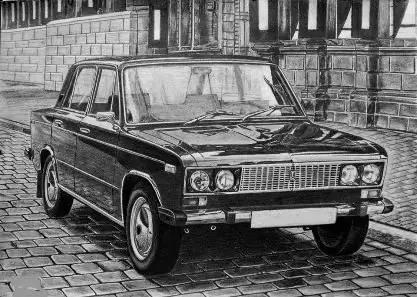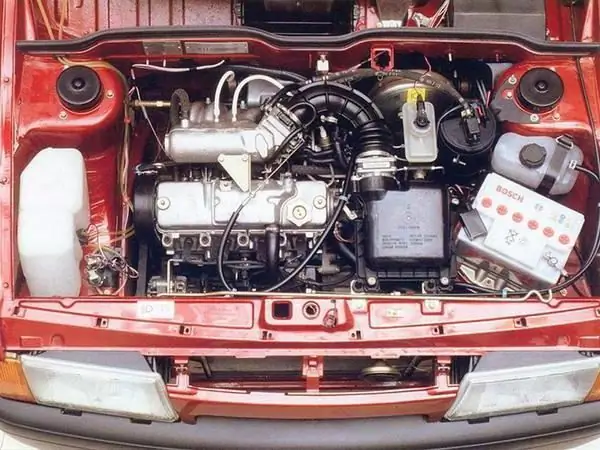2025 Author: Erin Ralphs | [email protected]. Last modified: 2025-01-22 21:14:11
In 1976, the VAZ plant began mass production of a new "sixth" model of a rear-wheel drive car. This car was in many ways similar to the "third" model, but was positioned as more prestigious and dynamic. This was achieved by using the 2106 engine, which had a cylinder capacity increased to almost 1.6 liters and higher power and torque ratings.
Due to its high power, the engine turned out to be suitable for use on the off-road "Niva" model 2121. Partly due to this, this engine turned out to be the longest-lived power unit of the "classic" family. To date, the production of several modifications of engines, created using the engine block of the "six", continues.
Main differences
The design of the new engine was based on solutions tested on existing VAZ power units. The main difference was the block, in which the diameter of the cylinders was increased by 3 mm. At the same time, the height of the counterweights on the crankshaft remained similar to the one and a half liter engine of the "third" model.
Due tothe increase in volume slightly increased the power characteristics of the 2106 engine to 80 forces. A four-speed gearbox with specially selected gears was docked to the motor. Thanks to her, the car could reach a speed of 152 km / h, which was a very good indicator at that time.

The applied volume increase technique has been used by designers before. This is how the "eleventh" 1.3-liter engine was created on the basis of a slightly bored block of the very first Togliatti 1.2-liter unit.
Further development
Based on the VAZ-2106 engine block, a model 21213 engine was created, which is widely used on Niva cars. To further increase the volume, the cylinders were bored out by another 3 mm in diameter, which gave an increase of almost 100 more cubes. The engine power reached 80 forces (as in the early "sixes"), but at the same time, the torque increased noticeably, it reaches 127 N / m. The motor is equipped with an electronic fuel injection system and is currently mass-produced.

Further boring of the block turns out to be impossible, since the wall thickness to the cooling channels is greatly reduced and possible casting defects begin to open. Technologically, they are admissible and can be located in the depth of the casting material. Therefore, a further increase in volume is achieved by increasing the piston stroke. This option is a rare 1.8-liter unit, with a piston stroke increased to 84 mm. Such motors develop up to 82 forces and were used onsome Niva models.
Engine block
The main part of the engine is the cylinder block, cast iron together with the lower part of the crankcase. In this part, there are seats for five supports of the main engine shaft. The lower covers of the supports are processed together with the crankcase and are not interchangeable with each other. All bearings are designed with thin-walled replaceable shells made from a special alloy. From the ends, the shaft is sealed with special sealing glands. The use of such parts prevents oil leakage during engine operation.

A coolant pump is installed on the front of the engine. The pump is driven by a conventional V-belt from the crankshaft pulley. The same belt drives the generator, located on the side of the crankcase of the 2106 engine. The generator is mounted on a special bracket and can be rotated relative to one of the supports. Due to this, the tension of the drive belt is adjusted. On the back of the block there is a clutch housing, on which a seat for a starter is made.
Block head
The top of the block is covered with an aluminum alloy die-cast head. The head contains the valve drive shaft, the valves themselves (two per cylinder) and spark plugs. A special gasket is installed between the head and the block, which ensures the tightness of the joint. The gasket is made of a special asbestos-based material and has an internal metal frame that ensures a longergasket life.

The head is attached to the block with 11 bolts, which are tightened with a certain force and in the planned sequence. This is done to ensure that the plane of the head is pressed evenly against the block. Any misalignment will result in gasket burnout, surface warping, and oil and coolant leaks.
Timing mechanism
The front of the engine is covered with an aluminum cover, behind which is the valve shaft drive chain. From the same circuit, the oil pump with a gear circuit is rotated. The pump is responsible for supplying pressurized oil to the bearings. Oil is taken from a reservoir located in a removable engine sump. To clean the oil, a filter with a replaceable paper element is used.

The valve drive shaft is located directly in the head. This design made it possible to provide good technical characteristics of the VAZ-2106 engine for its time. A photo of the motor is shown below.
The design of exhaust gas valves uses a combined design of two parts welded together. Both parts are made of steels of different grades. This scheme allowed for a higher durability of the part. The less thermally loaded inlet valve is made of one material. The surfaces of all valves undergo cycles of thermal and chemical treatment, which allows them towork in high temperatures.
Power and ignition system
Early versions of the 2106 engine used a Weber carburetor to supply fuel. With the start of production of more modern devices such as "Ozone", they began to be installed on the "sixth" engine. With the new carburetor, the engine became a little more economical, but also lost a few horsepower. In the early 2000s, engines began to be equipped with a fuel injection system. Such power units were equipped with cars of the "fifth" and "seventh" models.
On carbureted machines, ignition was used with the distribution of pulses from a mechanical device mounted on the side of the crankcase. The injection version is equipped with an electronic module that distributes ignition pulses according to signals from the engine shaft position sensor.
Basic revision
Due to the wide distribution and low price, the "six" motor often becomes an object of tuning. The 2106 engine is equipped with a new camshaft with modified phases and valve opening heights. At the same time, valves with an increased diameter are installed, which improves the filling of the cylinders.

The channels themselves for supplying and discharging working gases inside are thoroughly polished, since irregularities on the walls create turbulences in the flows of moving gases and worsen the operating parameters. These two methods are the most basic ways to increase the power of a 2106 engine.
In-Depth Improvements
A more advanced tuning option is to installlightweight crankshaft and cylinder boring to the maximum possible diameter - no more than 82 mm. Due to different shaft geometries, modified connecting rods with reduced weight are used. To further improve the power parameters, a supercharger is installed on the motor, which serves to increase the pressure.
VAZ-2106 engines are equipped with turbines from various vehicles. Supercharging allows you to significantly increase power, but at the same time, reliability and the overall resource of the power unit decrease. The maximum power of the forced versions of the "sixth" motor can reach 120-150 hp.
Recommended:
VAZ-2106 dashboard tuning: ideas and tips

Tuning the dashboard VAZ-2106: recommendations, features, changing the backlight and overlays. Tuning the dashboard VAZ-2106: instrument lighting, electronic speedometer, photo. How to do tuning the dashboard of the VAZ-2106 with your own hands?
VAZ-2106. Reviews, prices, photos and specifications

VAZ 2106 "Zhiguli" is a Soviet subcompact car with a body type "sedan", the successor of the VAZ 2103 model. The characteristics of the car met the requirements of that time, and the production of the VAZ 2106, the most popular and mass-produced car, continued for 30 years
Engine VAZ-2109. Tuning engine VAZ-2109

VAZ-2109 is perhaps one of the most famous and widespread cars in Russia. As you know, the VAZ of the “ninth family” was equipped with three power units. Each of them differed in power and working volume. Today we will look at how the engine works (VAZ-2109-21099) and find out how to tune it
Engine 4D56: specifications, photos and reviews

For the first time they started talking about in-line engines in 1860, when Etienne Lenoir designed his first unit. The idea was picked up by the auto industry instantly. The tasks of engineers of any era were to create a reliable model, and now the 4d56 engine pleases owners of passenger vehicles with its functionality. Excellent technical characteristics made it possible to use it on almost 10 models
"Mercedes "Volchok"": specifications, tuning, reviews and photos

"Mercedes "Volchok"" is a car that is known throughout the world as the "five hundredth". Only by hearing the name alone, you can understand what this unit is. Mercedes w124 e500 - a car that in the nineties was an indicator of we alth and we alth

